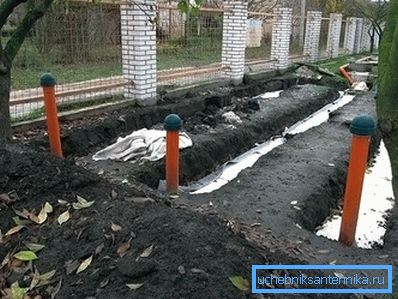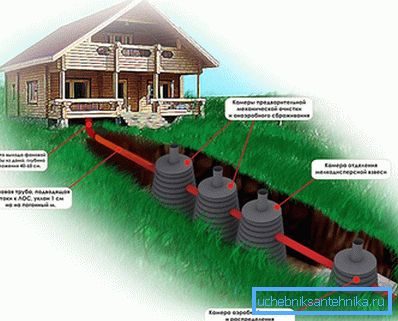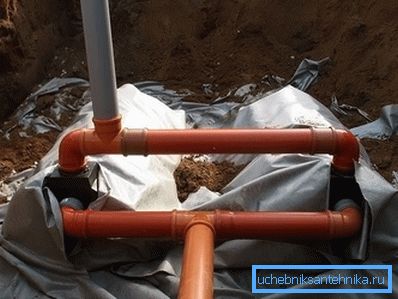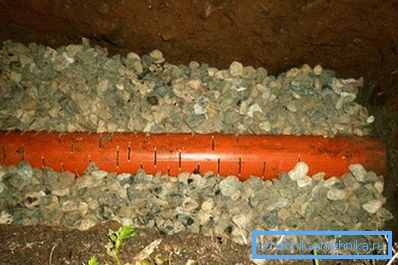Filtration field for septic tank
When organizing an autonomous purification system of a country house or a small commercial facility, household waste water after mechanical, biological and chemical cleaning does not reach 100% purity. Septic tanks with a mechanical phase have the lowest percentage. For complete processing of wastewaters before they are discharged into the ground, it is possible to make a filtration field for a septic tank. It is a specially prepared areas with a layer of gravel and sand. On these sites are placed pipes with many small holes for seepage from them drains. Pipes are filled with gravel, sand. The drains are filtered through the sand, finally being decontaminated. Filtration fields supplement the system of utilization and processing to complete cleaning, which corresponds to the current sanitary norms and rules.
Device

The location of filtration plots is determined by the project, taking into account the peculiarities of a particular land plot:
- At the selected site digging a pit or several trenches.
- The bottom is leveled.
- A layer of sand and gravel is laid on the bottom. Sand is recommended to use river. Career has clay inclusions and worse water filters. The thickness of such a filter must be at least a meter.
- The trench width for a single pipe branch should be 0.5-1.5 m.
- 20-30 cm of crushed stone of fraction 5-10 or 20-40 mm are laid on the sand.
- On it the drainage pipe keeps within. The diameter and length of the pipe depends on the required performance. Usually use pipes O 110-150 mm.
- From above, the pipes are filled with rubble, 20-30 cm thick.
- The dumped field is covered with geotextiles to prevent soil from entering the drainage system and its silting. Geotextiles are covered with primer.
- When pipes are laid above the ground freezing level, heat-insulating material is placed on top of the geotextile to prevent freezing of the filtration system.
The filtration network consists of an inlet pipe (also known as an outlet pipe from a septic tank), a distribution pipe (pipe system with outlets), drainage pipes and ventilation fungi (at the end of each drainage pipe).
What to consider

When designing filter fields, the following conditions should be considered:
- Soil structure at the site of the filtration fields. Layers can consist of soil layer, clay, loam, sandy loam, sand, peat. Each type of soil has a different degree of water transmission.
- Ground water level. The network of drainage pipes should be located 1–1.5 m higher than the groundwater level. With a high groundwater level, special embankments are made of the soil on which the filtration fields are located. In this case, the work on digging deep pits is excluded, but there is a need to construct a hill and insulate the entire field if the work of the cleaning system is required in the winter period.
- The filtration fields should be located at a distance from the house, sources of drinking water supply, water objects. Minimum distances are set by sanitary norms and rules. To drinking water sources and water bodies should be at least 30–50 m (depending on the permeability of soils).
- The system of distribution and drainage pipes should be laid under a slope. For a normal drift, it is enough to make a slope of 2–3 ° C.
- The depth of the drainage pipes should not exceed 2 m. Sewage is not easily filtered through the sand, but biological purification continues with the help of anaerobic bacteria. At great depths, the work of these bacteria can be difficult, despite the fact that they live and recycle organic pollution without oxygen.
- The area above the filtration field should be free from planting of vegetable and fruit crops. Fruit shrubs and trees should be located at a distance of 3-5 m. Also the site should be protected from the passage of vehicles on it.
Drainage wells

At low groundwater levels, instead of filtration fields, filtering devices can be constructed in the form of drainage wells. The design is an ordinary well round or square shape. The depth of the well should exceed the level of soil freezing by 1–2 m. When weatheating the drainage well, the depth can be reduced.
For arrangement of a well the ditch rummages. The diameter of the pit should be 1 m greater than the calculated size of the well. The bottom of the pit is filled with coarse-grained (river) sand with a height of at least 1 m. Further, a layer of rubble is laid 30–50 cm.
On the poured drainage cushion erected the walls of the well. They can be made of concrete rings, bricks, old tires, rubble, etc. The space between the walls of the pit and the well is filled with sand. It is necessary to provide an inlet in the wall of the well through which household sewage will be cleaned after a septic tank.

The effective life of the filter field or drainage well is 7–10 years with an estimated load. After this period, the filtering ability of the drainage layer is reduced, silting occurs with waste from sewage, the gradual transfer of sludge, soil, loam with groundwater. After leaving the service life, it is necessary to replace the drainage layer with a new one.

In some cases, the field or well may cease to function earlier than the specified period due to the siltation of the drainage layer. In this case, the drainage system will be disturbed, water absorption by the filtration field will be stopped, the operation of the septic tank, that is, the entire local cleaning system of a country house, will be stopped. The reason for clogging is the ingress of poorly treated wastewater into the field of filtration. This may be due to an incorrect calculation of the volume and performance of the local treatment system. Constant peak loads on the system as a result of the life activity of the residents, a large number of guests also contribute to the rapid silting. It is necessary to monitor the health of all elements and units of the septic tank, the constancy of energy supply, charging of batteries. If clogged, wash the silt drainage layer or change it.